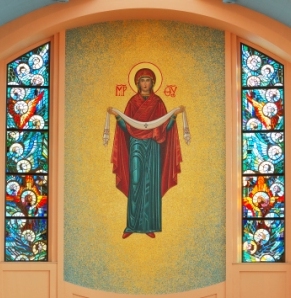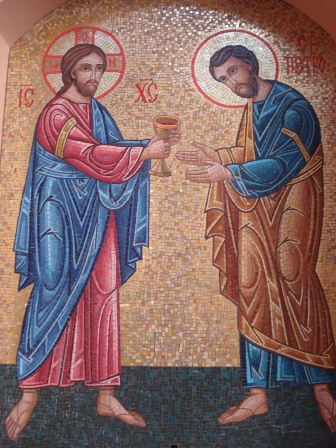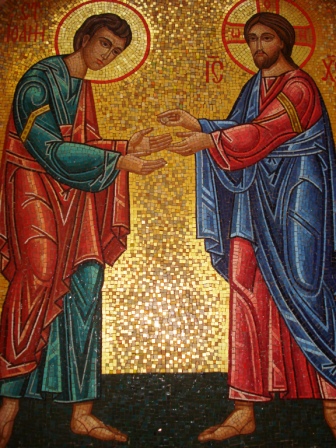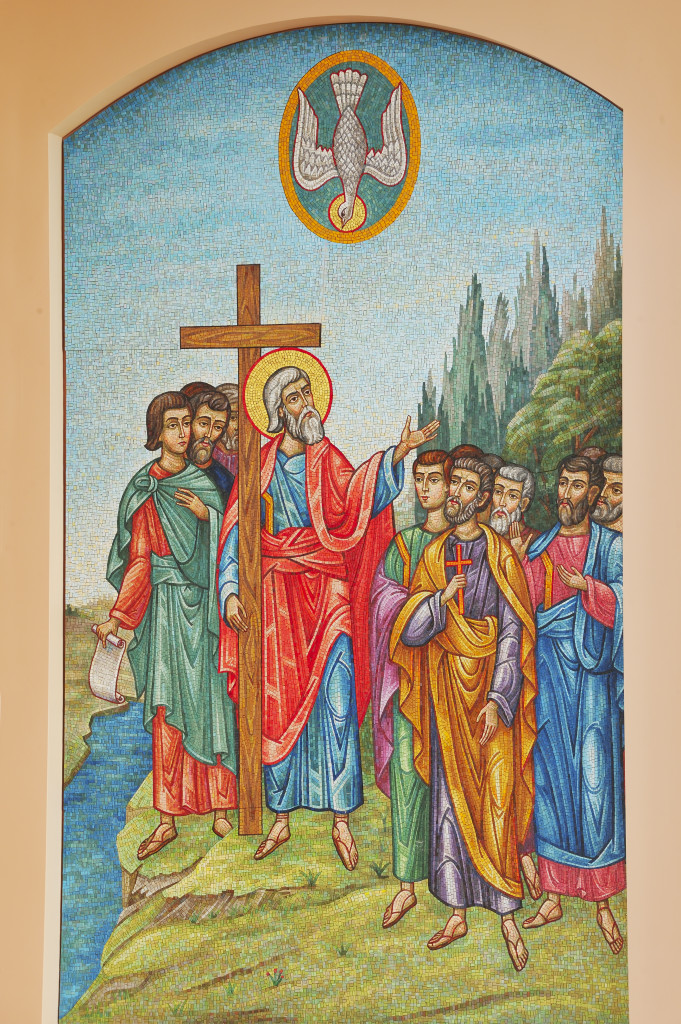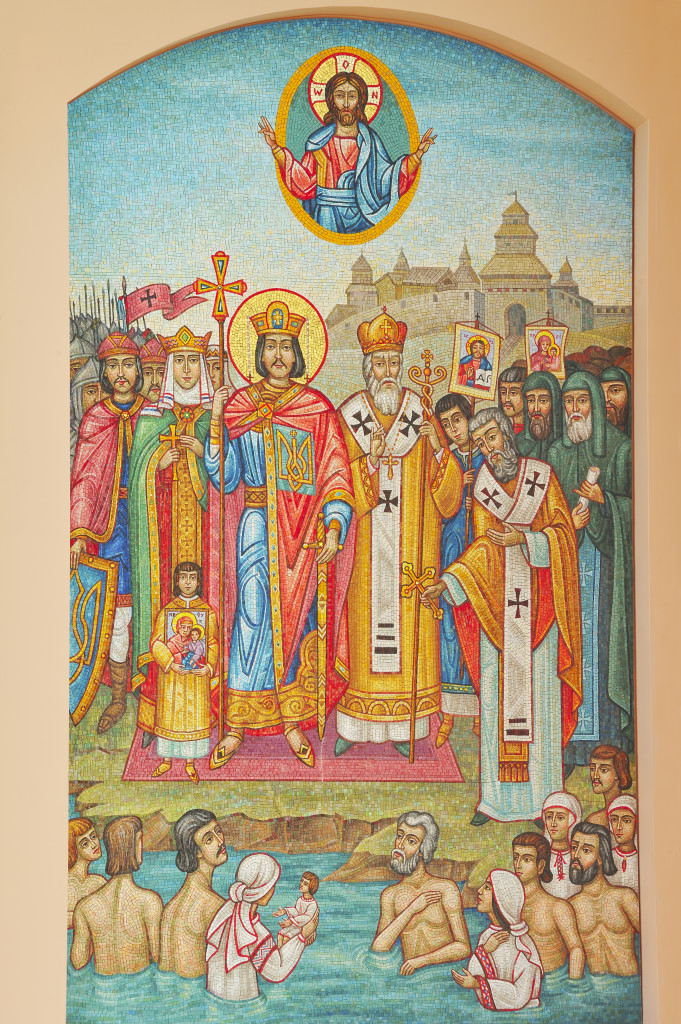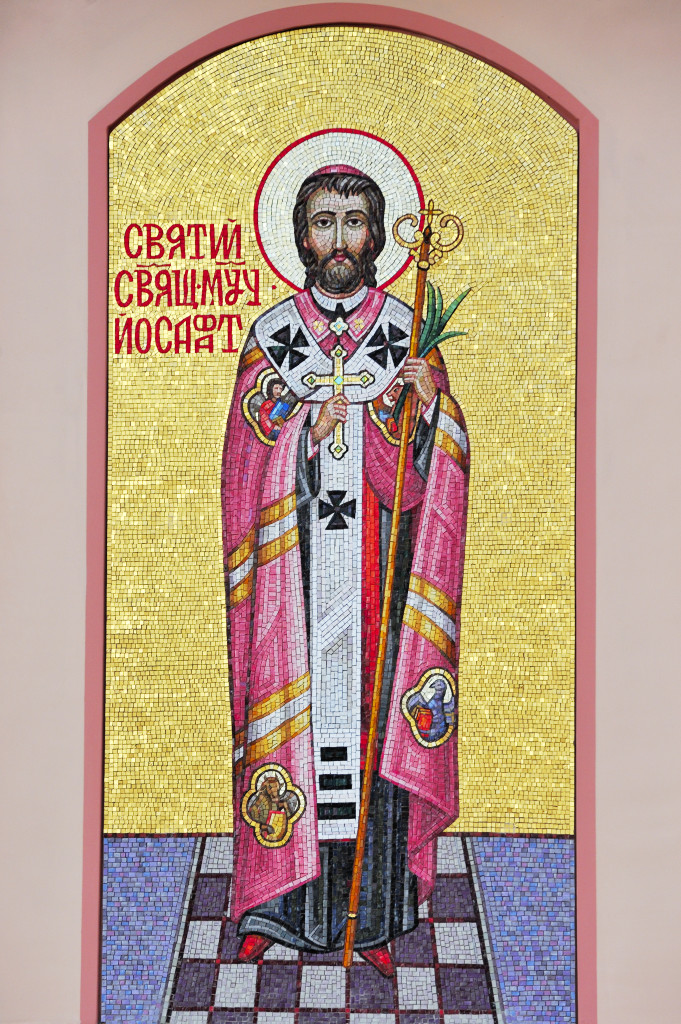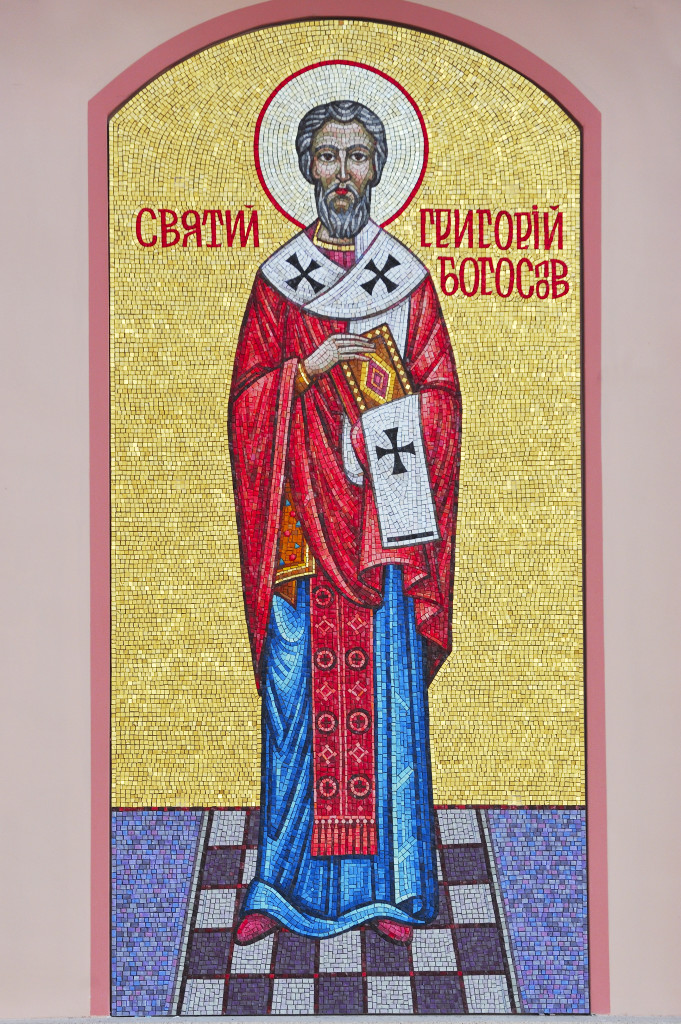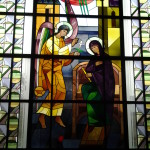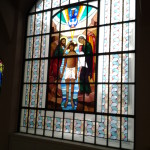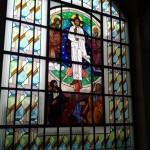Stained glass windows and mosaics in the church, designed by renowned iconographer Boris Makarenko of New York, were installed over a period of time ending in 1992.
The Sanctuary
The Sanctuary contains the main altar and two smaller preparatory tables. The Divine Liturgy is celebrated at the main altar.
When Constantinople was attacked in 903 A.D. by followers of Islam, the terror-stricken people gathered inside the church to pray for the intercession of the Mother of God, while the Christian army found outside. During the praying of Vespers, the Mother of God, surrounded by angels, prophets and apostles, appeared before the faithful. She spread an omophor, or veil, over them as a sign of her protection as she implored God’s mercy upon them. Miraculously, a storm destroyed many of the invaders. this icon tells us we are not alone but live in the presence of the Mother of God, our never-failing Protectress and ever-present advocate before God (Feast Day October 1)
Above the main altar is a large mosaic of Mary the Mother of God, the Protectress. She holds in her hands the Omophor, symbol of her Protection. The symbols on this icon include the Greek letters ΜΡ ΘΥ, which are on either side of the halo. This is the abbreviation for Mater tou Theo which is Greek for Mother of God. The mosaic measures 27 ‘x 15’ and is made from over 250,000 individual small mosaic tiles. The Stained-glass windows on either side of the mosaic depict the cherubim and seraphim.
Proskomydia (Preparation Table) Located on the East Wall on the left side of the main alter above the Proskomydia is an icon of Christ presenting the chalice to St. John.
Deakonikon (Vesting Table) Located on the East Wall on the right side of the main alter above the Deakonikon is an icon of Christ presenting bread to St. Peter.
The icon on the north sanctuary window represents the Crucifixion. The south icon depicts the Resurrection of Our Lord.
Side Altars
To the left side of the Sanctuary is an altar dedicated to the Blessed Mother of Perpetual Help. Above it is a mosaic of ST. Andrew on the hills of Kyiv.
To the right side of the Sancutary is the altar of Christ the Teacher. The mosaic of the Baptism of Ukraine in 988 is installed above this altar
The Dome
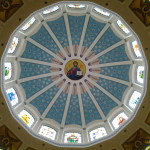 The drum of the main dome contains stained glass icons of the Apostles. Painted on the Dome is an icon of Christ the Pantocrator- the Universal Ruler.
The drum of the main dome contains stained glass icons of the Apostles. Painted on the Dome is an icon of Christ the Pantocrator- the Universal Ruler.
Other Icons
Opposite the Marian altar is a mosaic depicting the history of our Parish. The buildings are of the Basilian Monastery in Mundare, Alberta, the old St Mary’s Church on Princess street and the current building. Bishop Nicetas Budka (Canada’s first Ukrainian Catholic Bishop) is shown with the first immigrants.
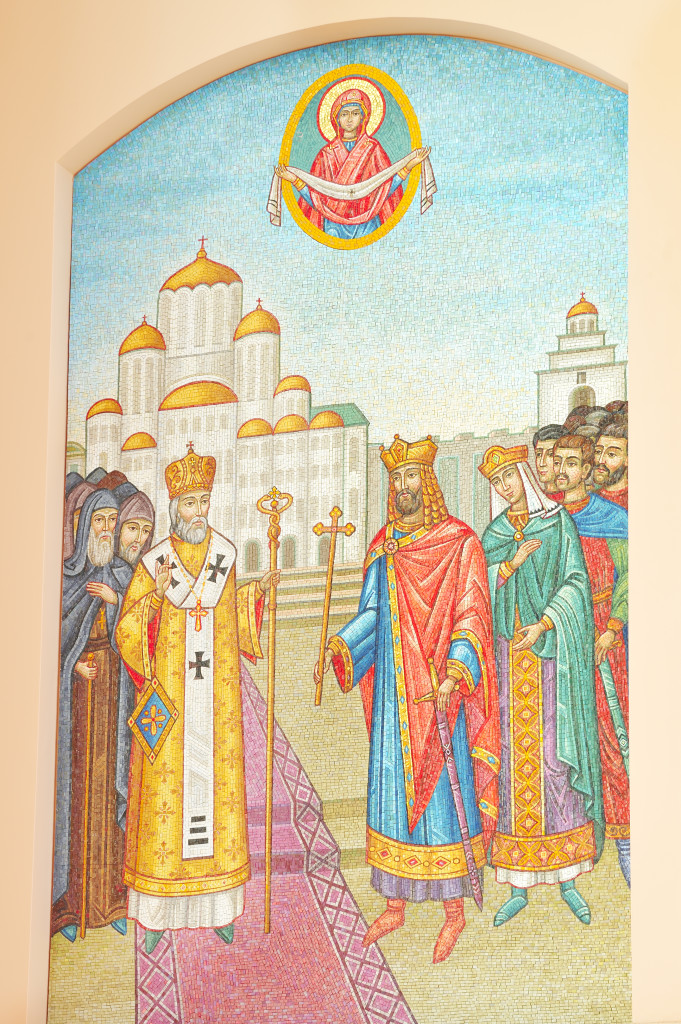 On the south-west wall is a mosaic depicting the consecration of Ukraine (c.1030) by Yaroslav the Wise to the Protection of the Mother of God.
On the south-west wall is a mosaic depicting the consecration of Ukraine (c.1030) by Yaroslav the Wise to the Protection of the Mother of God.
To the left side of the Sanctuary is an altar dedicated to the Blessed Mother of Perpetual Help. Above it is a mosaic of St Andrew on the hills of Kyiv.
To the right side of the Sanctuary is the altar of Christ the Teacher. The mosaic of the Baptism of Ukraine in 988 is installed above this altar.
St Gregory of Nazianzus
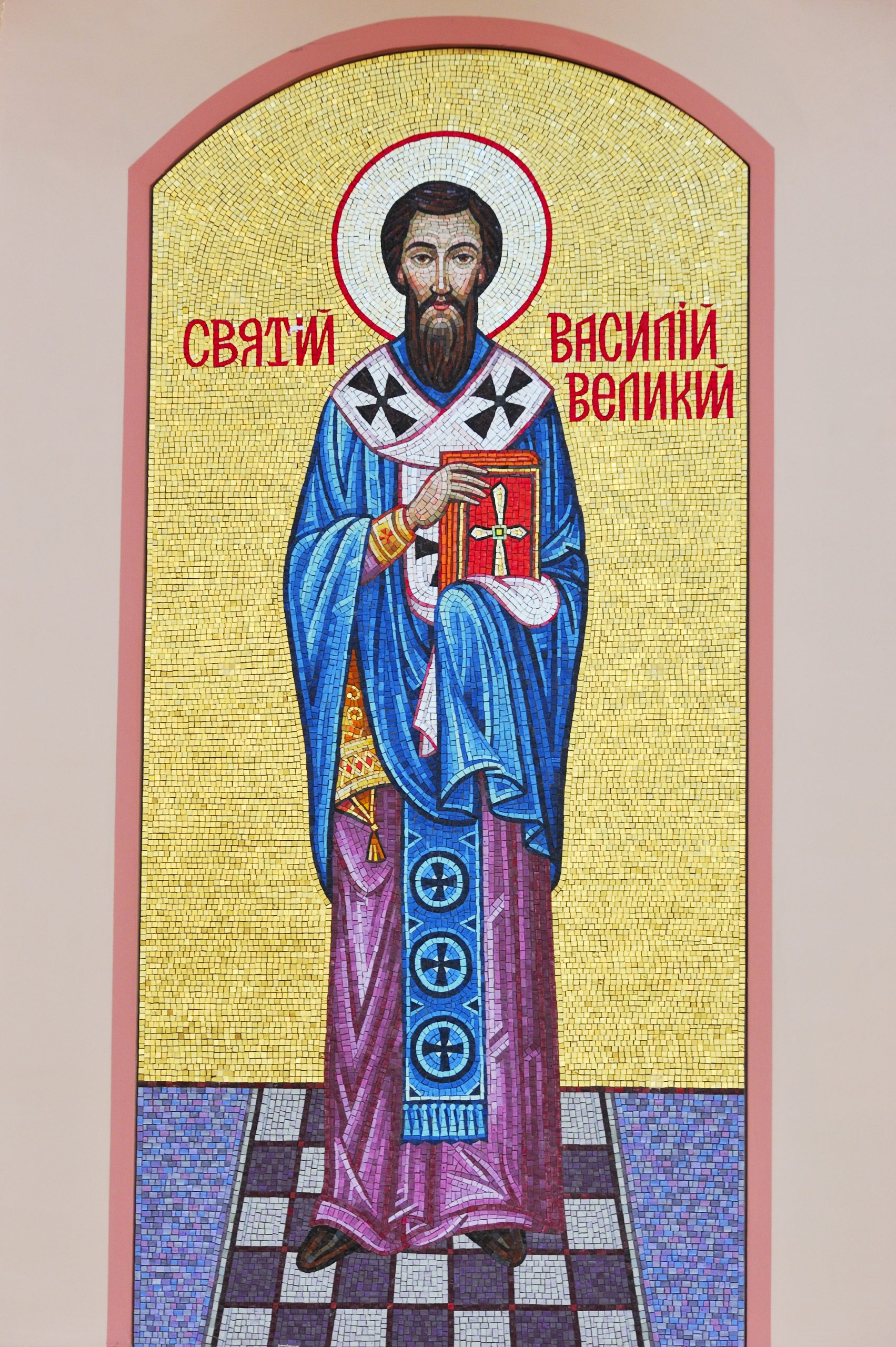
Saint Basil the Great – Feast Day – January 1st Bishop and Doctor of the Church (329-379)
Saint Basil was born in Asia Minor in 329. Two of his brothers became bishops, and with his mother and his sister, are honoured as Saints. He studied with great success in Athens, where he formed a tender and perpetual friendship with Saint Gregory Nazianzen. He then taught oratory. The study of philosophy had already raised him above all worldly ambition, and dreading the honours of the world, he gave up all things to become the father of monastic life in the East. His older sister, Saint Macrina, encouraged him when he abandoned the greater part of his inheritance. He retired into Pontus, where his sister was Superior of a convent, into which his mother also had entered; there he founded a monastery on the opposite side of the river from the convent, and governed it for four years, from 358 to 362. He founded several other religious houses in the same region, both for men and for women. It was for them that he composed his ascetic works, including his famous Rule, still followed by the monks of the Orient.
He then resigned, leaving his office to his brother, Saint Peter of Sebastus, to retire in prayer. Saint Gregory came to join his friend for a time, in response to his invitation. Ever afterwards, Basil would recall with regret the peace and happiness they had enjoyed, singing Psalms, studying Scripture, keeping vigil in prayer, and disciplining their flesh by manual work. It was only in 363 that this holy hermit was ordained a priest
by Eusebius of Caesarea in Cappadocia. The Arian heretics, supported by the court, were then persecuting the Church, and Basil was summoned from his retirement by his bishop to give aid against them. His energy and zeal soon mitigated the disorders of the Church, and his solid and eloquent words silenced the heretics. On the death of Eusebius, he was chosen Bishop of Caesarea. His commanding character, his firmness and energy, his learning and eloquence, seconded by his humility and the great austerity of his life, made him a model for bishops. He founded in Caesarea a vast hospital, which Saint Gregory called a new city and which remained in existence for long decades. He went there often to
console the suffering, and help them to make good use of their pains. When Saint Basil was summoned by the emperor Valentius to admit the Arians to Communion, the prefect in charge, finding that soft words had no effect, said to him, “Are you mad, that you resist the will before which the whole world bows? Do you not dread the wrath of the emperor, nor exile, nor death?” “No,” said Basil calmly; “he who has nothing to lose need not dread loss of goods; you cannot exile me, for the whole earth is my home; as for death, it would be the greatest kindness you could bestow
upon me; torments cannot harm me; one blow would end both my frail life and my sufferings.” The prefect answered, “Never has anyone dared to address me thus.” “Perhaps,” suggested Basil, “you never before measured your strength with a Christian bishop.” The emperor desisted from his commands. Saint Basil’s entire life was one of suffering, both physical and moral; he lived amidst jealousies, misunderstandings and seeming disappointments. But he sowed the seed which bore good fruit in the future generations. He was God’s instrument to resist the Arian and other heretics in the East, and to restore the spirit of discipline and fervor in the Church. He died peacefully in 379 at the age of fifty-one, and is venerated as a Doctor of the Church. https://sanctoral.com/en/saints/saint_basil_the_great.html
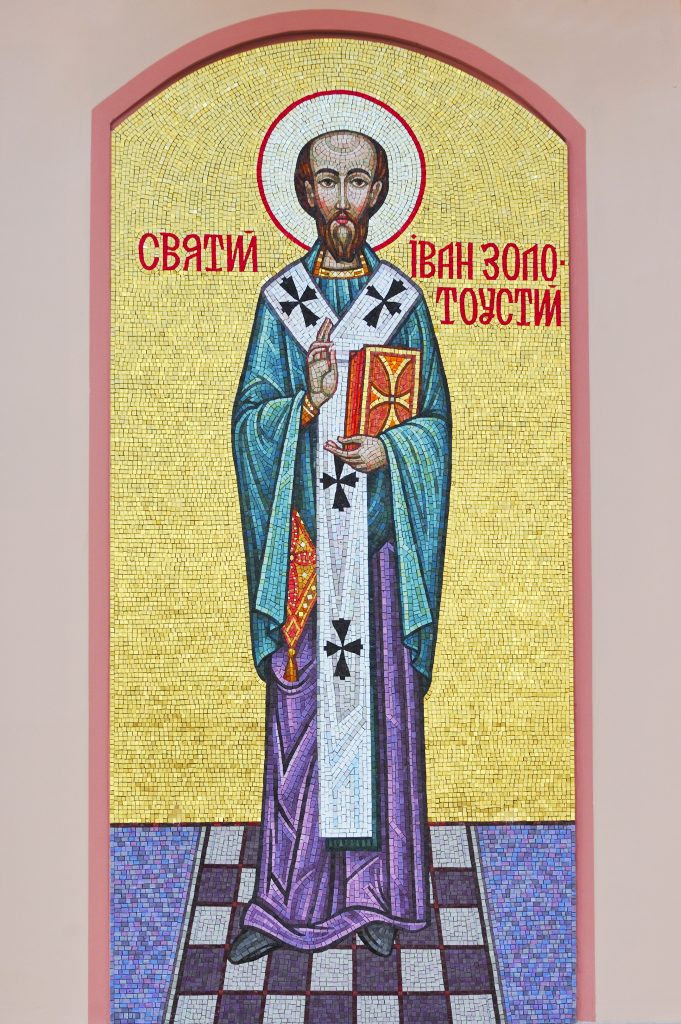
The stained glass windows located throughout the Church depict events in the life of the Blessed Virgin Mary

